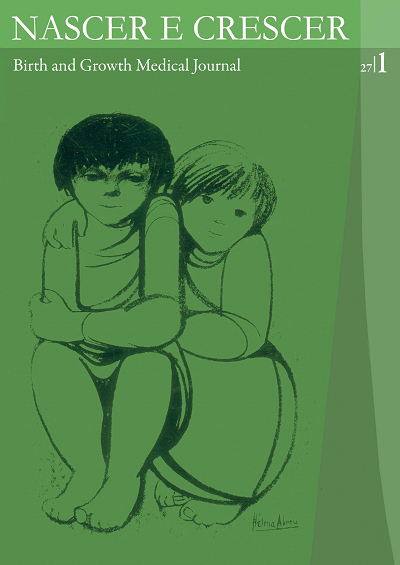Subclinical Hypothyroidism in Children and Adolescents: a single-center retrospective study
DOI:
https://doi.org/10.25753/BirthGrowthMJ.v27.i1.11956Keywords:
Childhood, levothyroxine treatment, subclinical hypothyroidismAbstract
Introduction: The ideal management of subclinical hypothyroidism, particularly the mild form, remains unclear. Our objectives were to describe the clinical management of subclinical hypothyroidism in children and adolescents and the natural course of the disease with conservative management.
Material and Methods: We retrospectively analyzed clinical records of patients, under the age of 18 years, referred to our pediatric endocrinology department due to subclinical hypothyroidism between 2009 and 2014, with ≥1 year of followup. Patients under one month of age and with TSH (thyroidstimulating hormone) levels <5 uUI/mL were excluded. Subclinical hypothyroidism was considered when TSH levels >5 uUI/mL with a normal serum free thyroxine. Mild and severe subclinical hypothyroidism were defined when TSH was <10 uUI/mL and ≥10 uUI/mL, respectively.
Results: We included 69 patients (62.3% girls) with a median age at diagnosis of 8.0 [(25th percentile-75th percentile (P25-P75): 4.75-11.0)] years. Most of the patients (80.6%) were symptomatic and Hashimoto thyroiditis was the most frequent identified cause. A mild form of subclinical hypothyroidism was diagnosed in 79.7% of the patients. All patients with severe subclinical hypothyroidism initiated therapy with levothyroxine in contrast with 43.6% in the mild subclinical hypothyroidism group. Among patients not treated, 73.3% had TSH normalized after one year of follow-up and none progressed to overt hypothyroidism.
Conclusion: The mild form of subclinical hypothyroidism was the most common typepf disease and, among patients managed conservatively, the majority presented normal thyroid function after one year of follow-up and none progressed to overt hypothyroidism. Our results reinforce the idea that, in most patients, subclinical hypothyroidism is a benign condition with a low risk of progression to overt thyroid dysfunction. However, further studies are needed to evaluate the potential long-term effects of the condition in untreated patients and to clarify the best clinical approach and follow-up strategy.
Downloads
References
Lazarus J, Brown RS, Daumerie C, Hubalewska-Dydejczyk A, Negro R, Vaidya B. 2014 European thyroid association guidelines for the management of subclinical hypothyroidism in pregnancy and in children. Eur Thyroid J. 2014; 3:76-94. Available from: http://www.pubmedcentral.nih.gov/articlerender.fcgi?artid=4109520&tool=pmcentrez&rendertype=abstract.
Salerno M, Capalbo D, Cerbone M, De Luca F. Subclinical hypothyroidism in childhood - current knowledge and open issues. Nat Rev Endocrinol. 2016; 12:734-746. doi: 10.1038/nrendo.2016.100.
Monzani A, Prodam F, Rapa A, Moia S, Agarla V, Bellone S, et al. Endocrine disorders in childhood and adolescence. Natural history of subclinical hypothyroidism in children and adolescents and potential effects of replacement therapy: a review. Eur J Endocrinol. 2013; 168:1–11.
Cerbone M, Capalbo D, Wasniewska M, Raso GM, Alfano S, Meli R, et al. Cardiovascular risk factors in children with longstanding untreated idiopathic subclinical hypothyroidism. J Clin Endocrinol Metab. 2014; 99:2697–703.
Sert A, Pirgon O, Aypar E, Yilmaz H, Odabas D. Subclinical Hypothyroidism as a Risk Factor for the Development of Cardiovascular Disease in Obese Adolescents With Nonalcoholic Fatty Liver Disease. Pediatr Cardiol. 2013;1-9.
Unal E, Akın A, Yıldırım R, Demir V, Yıldız İ, Haspolat YK. Subclinical hypothyroidism in children may lead to dyslipidemia and increased carotid intima-media thickness. J Clin Res Pediatr Endocrinol. 2016. Available from: http://www.ncbi.nlm.nih.gov/pubmed/28008862
Lee YJ, Jung SY, Jung HW, Kim SY, Lee YA, Lee SY, et al. Unfavorable Course of Subclinical Hypothyroidism in Children with Hashimoto’s Thyroiditis Compared to Those with Isolated Non-Autoimmune Hyperthyrotropinemia. J Korean Med Sci. 2017; 32:124. Available from: http://www.ncbi.nlm.nih.gov/pubmed/27914141
Such K, Gawlik A, Dejner A, Wasniewska M, Zachurzok A, Antosz A, et al. Evaluation of Subclinical Hypothyroidism in Children and Adolescents: A Single-Center Study. Int J Endocrinol. Hindawi Publishing Corporation. 2016.
Radetti G. Clinical Aspects of Hashimoto’s Thyroiditis. In: Endocrine development. 2014: 158–70. Available from: http://www.ncbi.nlm.nih.gov/pubmed/25231451
Kaplowitz PB. Subclinical hypothyroidism in children: normal variation or sign of a failing thyroid gland? Int J Pediatr Endocrinol. 2010; 2010:281453. doi: 10.1155/2010/281453.
Rapa A, Monzani A, Moia S, Vivenza D, Bellone S, Petri A, et al. Subclinical hypothyroidism in children and adolescents: a wide range of clinical, biochemical, and genetic factors involved. J Clin Endocrinol Metab. 2009; 94:2414–20.
Radetti G, Maselli M, Buzi F, Corrias A, Mussa A, Cambiaso P, et al. The natural history of the normal/mild elevated TSH serum levels in children and adolescents with Hashimoto’s thyroiditis and isolated hyperthyrotropinaemia: A 3-year follow-up. Clin Endocrinol. 2012; 76:394–8.
Downloads
Published
How to Cite
Issue
Section
License
Copyright and Authors' Rights
All articles published in Nascer e Crescer - Birth and Growth Medical Journal are Open Access and comply with the requirements of funding agencies or academic institutions. For use by third parties, Nascer e Crescer - Birth and Growth Medical Journal adheres to the terms of the Creative Commons License "Attribution - Non-Commercial Use (CC-BY-NC)".
It is the author's responsibility to obtain permission to reproduce figures, tables, etc. from other publications.
Authors must submit a Conflict of Interest statement and an Authorship Form with the submission of the article. An e-mail will be sent to the corresponding author confirming receipt of the manuscript.
Authors are permitted to make their articles available in repositories at their home institutions, provided that they always indicate where the articles were published and adhere to the terms of the Creative Commons license.


